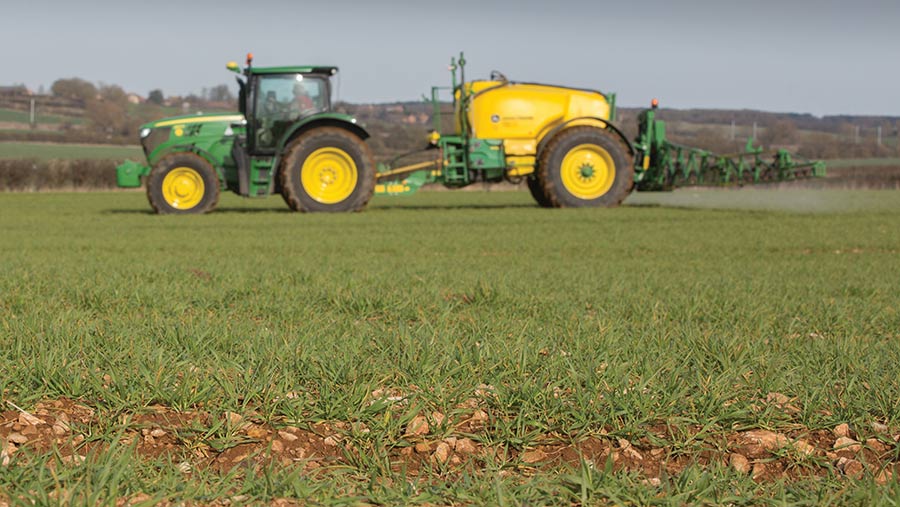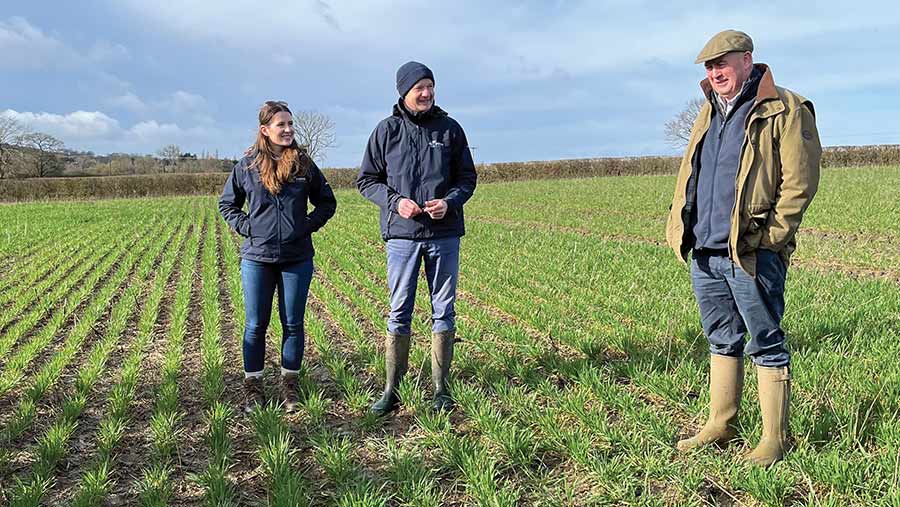How to tackle hefty spring arable workloads after wet winter
 © Tim Scrivener
© Tim Scrivener Spring workloads are mounting on most arable farms, so sorting fieldwork priorities to ensure optimum return on investment where crops are variable and harvest profitability remains uncertain is a tricky task.
On better-drained sites, travelling in tramlines has proved possible ahead of moving soil to get spring drilling started – giving a week or more of spraying or spreading time to help structure the spring to-do-list.
After such a difficult winter, crops with poor root systems and low tiller numbers should be treated with care, advises Will Vaughan France, south-west regional agronomist at Niab, who cautions against applying big, complex tank mixes just because jobs are stacking up.
See also: How to get spring barley off to a good start
“It is a balancing act this year,” he acknowledges. “Many crops aren’t in good condition and there’s variability even within fields. Nitrogen is the priority for most of these crops and manganese will be essential on some.”
He also stresses that there isn’t anything that can be applied from a can or a bag to solve waterlogging. “If rooting is a concern after flooding or very high rainfall, the best thing that you can do is to get the crop growing.”
Disease threats won’t be obvious until the weather warms up and rainfall patterns emerge, adds Will.
“Early sprays will be variety-specific and a function of the problems that are apparent at the spray timing.”
“We are seeing what we normally find at this time of the year. The usual suspect varieties are carrying some disease, but there’s nothing causing particular concern.”
Nitrogen
Given crop variability, nitrogen applications are one of the first tasks being undertaken, says Jock Willmott, independent agronomist and partner at Ceres Rural, who stresses that a rate specific to the situation and the weather forecast is required.
A nitrogen price that equates to £1/kg means it should be business as usual on rates where wheat crops established well, as it is still worth looking after the crops that will provide a good return.
“The lower nitrogen price is helping, even with wheat at £150/t,” he notes. “There is margin on wheat at current grain prices. Don’t compromise too much.”
Actives
Herbicides
- Atlantis Star – iodosulfuron + mesosulfuron + thiencarbazone
- Avadex – Tri-allate
- Axial – pinoxaden
- Broadway Star – florasulam + pyroxsulam
- Crystal – flufenacet + pendimethalin
- Hurricane – diflufenican
- Horus – iodosulfuron + mesosulfuron
Fungicides
- Univoq – fenpicoxamid + prothioconazole
His suggestion is to feed the stronger crops first, followed by those on early land before getting to the backwards crops. “This last group, which has lower potential, should be fed early and then a review of total nitrogen carried out.”
The situation with winter barley is less certain. “This is where it’s all a bit sketchy. You will need a high-yielding crop of 7.5-8t/ha to break even, although straw sales may help with that figure,” says Jock.
Rooting
Late-drilled crops that were not rolled in the autumn or have since suffered from frost lift will have poorer root systems.
“Once soils start to dry, crops will grow, even with small root systems – so that’s why nutrients are needed.
“If you can get rolls onto crops in puffy seed-beds, then it’s probably a good idea. Remember that the cut-off is growth stage 30-31.”
There is a plethora of products marketed for rooting, he continues.
“My preference is to get the macro-nutrition right and make sure you don’t roll too early. Some plant growth regulators (PGRs) influence rooting, but their main role is to thicken the crop by stopping the main tiller.”
PGRs
Alice Cannon, technical support manager at Hutchinsons, believes timely application of PGRs could offset some of the damage caused by waterlogging and flooding, but says this is dependent on product choice, rates and timing.
She notes the potential of early PGRs at T0 and T1 to manipulate crops beyond straw shortening to include stem width and diameter could be useful – especially shallow-rooted crops that may be more prone to lodging as biomass develops.
Tiller survival is another benefit of early PGR use, she continues. “Losing tillers at stem extension is not something that we want to see this year after a compromised foundation period.
“The focus should be on keeping green leaf area going through March, which is why GS30 is a key timing this year.”
T0 Sprays
Most T0 sprays will be targeted at yellow rust, says George Hoyes of Ceres Rural.
“It’s variety specific, but there is rust around and it’s not a disease you want to keep seeing as the season progresses. If you find it, an application of tebuconazole will usually suffice.”
Other T0 options include strobilurins and mildew-specific products.
The earlier drilled crops, which are thicker and have higher yield potential, are the most obvious candidates for a T0, he suggests.
“There is some disease around after such a mild winter and thicker stands have less air flow around them. They need close monitoring over the coming weeks.”
He reminds growers to check the compatibility of products where a tank-mix might contain herbicide, rust fungicide and early PGR.
What about weed control?
Grassweed control is also a priority for many farmers, with any required spring activity dependent on what was achieved in the autumn.
There’s nothing approved for use on oats and the situation in barley is similar – just Axial for wild oat control remains.
Where pre- and post-emergence sprays went onto wheat as planned, the advice is to check for any brome.
If the pre-emergence went on, but there was no follow-up, growers need to weigh up the need for another spray and whether it’s worth using a spring-applied product such as Horus, Broadway Star or Atlantis Star.
Case Study – Peter Sinnott, Bedfordshire

Louise Penn, Charlie Ireland and Peter Sinnott © Louise Impey
Late September drilled milling wheat at Hayfield Farm, Aspley Guise in Bedfordshire has already received 40kg N/ha this spring.
Targeted weed control and PGRs are planned for the next few weeks, along with the first fungicide.
Grower Peter Sinnott is pleased that the autumn 2023 operations were completed in good conditions, despite some fears about the drilling date implications for blackgrass populations on parts of the farm.
Having drilled some of the wheat with an Avatar following a mustard catch crop – introduced for the first time in autumn 2023 as part of a plan to reduce cultivations and minimise compaction – grassweed germination was less than anticipated in those fields.
Even so, a pre-emergence programme of Avadex/Crystal/Hurricane was applied and Peter’s agronomist Louise Penn is weighing up whether a spring application of Horus is required in certain areas.
Also on the agenda is a good PGR programme – both Extase and Dawsum are being grown – with an early T0 spray timing planned.
“This will allow tebuconazole to be added so that any yellow rust can be dealt with,” adds Louise.
As Peter targets the milling premium, total nitrogen will be in the region of 240kg/ha and will be guided by the use of protein prediction tests.
Looking at fungicides, Univoq at T2 was used for the previous two years on the farm and is likely to feature again this year.
Despite new fungicide options available, Louise doesn’t expect to make major changes.
“As always, fungicide programmes will be developed according to the disease risk, drilling date, the variety being grown and the weather.”

